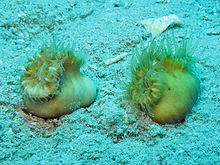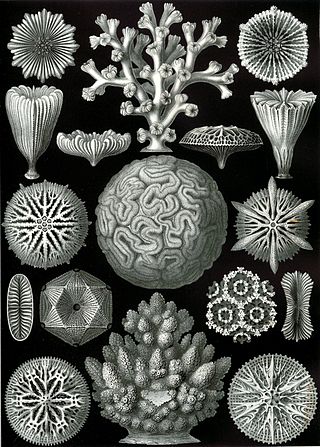
Scleractinia, also called stony corals or hard corals, are marine animals in the phylum Cnidaria that build themselves a hard skeleton. The individual animals are known as polyps and have a cylindrical body crowned by an oral disc in which a mouth is fringed with tentacles. Although some species are solitary, most are colonial. The founding polyp settles and starts to secrete calcium carbonate to protect its soft body. Solitary corals can be as much as 25 cm (10 in) across but in colonial species the polyps are usually only a few millimetres in diameter. These polyps reproduce asexually by budding, but remain attached to each other, forming a multi-polyp colony of clones with a common skeleton, which may be up to several metres in diameter or height according to species.

A salp or salpa is a barrel-shaped, planktonic tunicate in the family Salpidae. It moves by contracting, thereby pumping water through its gelatinous body, one of the most efficient examples of jet propulsion in the animal kingdom. The salp strains the pumped water through its internal feeding filters, feeding on phytoplankton.

Spirobranchus giganteus, commonly known as the Christmas tree worm, is a tube-building polychaete worm belonging to the family Serpulidae.

The open brain coral is a brightly colored free-living coral species in the family Merulinidae. It is the only species in the monotypic genus Trachyphyllia and can be found throughout the Indo-Pacific.

Acroporidae is a family of small polyped stony corals in the phylum Cnidaria. The name is derived from the Greek "akron" meaning "summit" and refers to the presence of a corallite at the tip of each branch of coral. They are commonly known as staghorn corals and are grown in aquaria by reef hobbyists.

Ancylomenes venustus, also known as the graceful anemone shrimp, is a species of shrimp which belongs to the family of the Palaemonidae. This species is found in the tropical waters from the centre of the Indo-Pacific biogeographical area. A. venustus lives in association with scleractinians and actiniarians and is a cleaner shrimp.

Pocillopora verrucosa, commonly known as cauliflower coral, rasp coral, or knob-horned coral, is a species of stony coral in the family Pocilloporidae. It is native to tropical and subtropical parts of the Indian and Pacific Oceans.
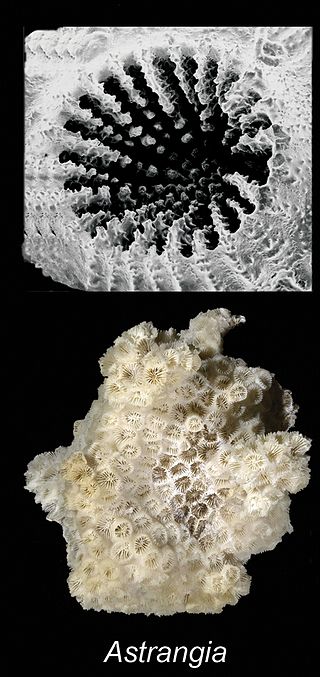
Astrangia poculata, the northern star coral or northern cup coral, is a species of non-reefbuilding stony coral in the family Rhizangiidae. It is native to shallow water in the western Atlantic Ocean and the Caribbean Sea. It is also found on the western coast of Africa. The International Union for Conservation of Nature lists this coral as being of "least concern". Astrangia poculata is an emerging model organism for corals because it harbors a facultative photosymbiosis, is a calcifying coral, and has a large geographic range. Research on this emerging model system is showcased annually by the Astrangia Research Working Group, collaboratively hosted by Roger Williams University, Boston University, and Southern Connecticut State University
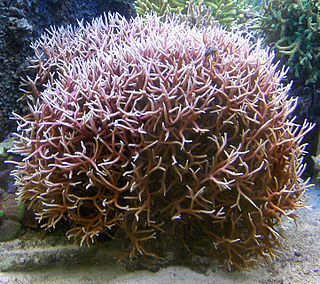
Seriatopora hystrix is a species of colonial stony coral in the family Pocilloporidae. It forms a branching clump and is commonly known as thin birdsnest coral. It grows in shallow water on fore-reef slopes or in sheltered lagoons, the type locality being the Red Sea. It is native to East Africa, the Red Sea and the western Indo-Pacific region. It is a common species and the International Union for Conservation of Nature has assessed its conservation status as being of "least concern".

Madracis auretenra, commonly known as the yellow finger coral or yellow pencil coral, is a colonial species of stony coral in the family Pocilloporidae. It is a fairly common species and is found in the Caribbean Sea and western Atlantic Ocean. At one time this species was not recognised, but it was split from Madracis mirabilis on the grounds of morphology and depth range.
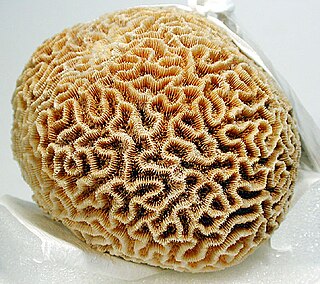
Goniastrea favulus, also known as the lesser star coral, is a species of stony coral in the family Merulinidae. It occurs in shallow water in the Indo-Pacific region. This is an uncommon species of coral and the International Union for Conservation of Nature has rated its conservation status as being "near threatened".
Cycloseris curvata is a species of disc coral in the family Fungiidae. Cyclosteris curvata is a mostly solitary free living scleractinian disc coral found in the indo-pacific region. They grow on soft substrates and are known to tolerate turbid waters. Like other anthozoan corals they lack a medusa stage characteristic of other cnidarians. They have been observed as both green and brown in color in the field.

Diogenes heteropsammicola is a species of hermit crab discovered during samplings between 2012 and 2016 in the shallow waters of the Japanese Amami Islands. This D. heteropsammicola is strongly associated with the walking corals. This hermit crab species is unique due to the discovery that they use living, growing coral as a shell. The live in the inside of the coral and vary from other types of hermits. Crustaceans of this type commonly replace their shell as the organism grows in size, but D. heteropsammicola are the first of their kind to use solitary corals as a shell form. Heteropsammia and Heterocyathus are the two solitary corals that this hermit species has been observed as occupying. These two coral species are also used as a home by symbiotic sipunculans of the genus Aspidosiphon, which normally occupy the corals that the were previously occupied by crabs.
Horastrea is a monotypic genus of stony coral in the family Coscinaraeidae. It is represented by the single species Horastrea indica, the blister coral. It is native to the southwestern Indian Ocean where it is found in shallow water sandy reefs. It was first described by M Pichon in 1971. It is an uncommon coral and the International Union for Conservation of Nature has assessed it as being a "vulnerable species".

Aspidosiphon muelleri is a species of unsegmented benthic marine worm in the phylum Sipuncula, the peanut worms. This worm is found in the eastern Atlantic Ocean, the Mediterranean Sea and in various locations in the Indo-Pacific region at depths down to about 1,000 m (3,300 ft).

Heterocyathus aequicostatus is a small species of coral in the family Caryophylliidae in the order Scleractinia, the stony corals. It is native to the Indo-Pacific region. It is a large polyp, solitary, free-living coral and is usually found on soft substrates.

Heterocyathus is a genus of coral of the family Caryophylliidae.

Tubastraea tagusensis is a hard coral species in the family Dendrophylliidae. The species is azooxanthellate, thus does not need sunlight for development, and does not form reefs. It is native to the Galapagos Islands but has become invasive along the Atlantic coast of South America.
Petaloconchus keenae is a worm snail common in intertidal and subtidal areas in Hawaiʻi and the tropical Pacific. It has a symbiotic relationship with multiple coral genera, such as Porites, Montipora, and Pavona.
